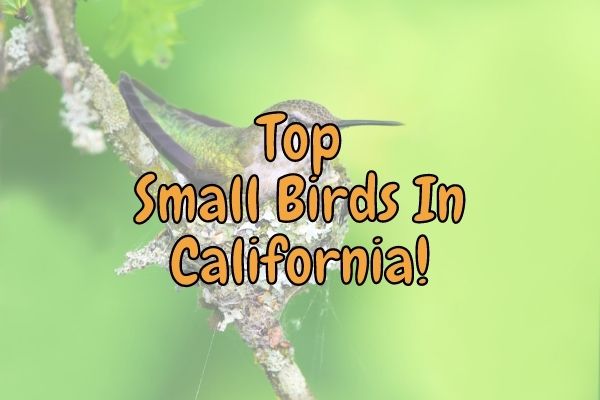There are a variety of small birds that call California home. Some of the more common species include the house finch, American goldfinch, and black-capped chickadee.
While each bird is unique, they all share a love for the Golden State.
The small birds listed here can be observed in Northern California as well as in the Southern parts of California.
Whether you’re hiking through the redwoods or strolling along the beach, keep your eyes peeled for these feathered friends. You might just be surprised at how many different types of small birds you can find in California!
Below is a table listing all the smallest birds (weighing less than 3.5oz) observed in California:
- House Finch
- White-crowned Sparrow
- Anna’s Hummingbird
- Lesser Goldfinch
- California Scrub-Jay
- California Towhee
- Dark-eyed Junco
- Oak Titmouse
- Pine Siskin
- Golden-crowned Sparrow
- Chestnut-backed Chickadee
- Bewick’s Wren
- Yellow-rumped Warbler
- House Sparrow
- Spotted Towhee
- American Goldfinch
- White-breasted Nuthatch
- Ruby-crowned Kinglet
- Northern Mockingbird
- Song Sparrow
So as can be seen from the list, the House Finch is the winner and in the graph below, you can see that it actually quite a lot more abundant than the second most prevalent Withe-Crowned Sparrow.
Anna’s Hummingbird is an interesting one, as it is actually not found in these numbers anywhere else in North America!
This can be compared to the 30 most common total birds observed in Californian backyards:
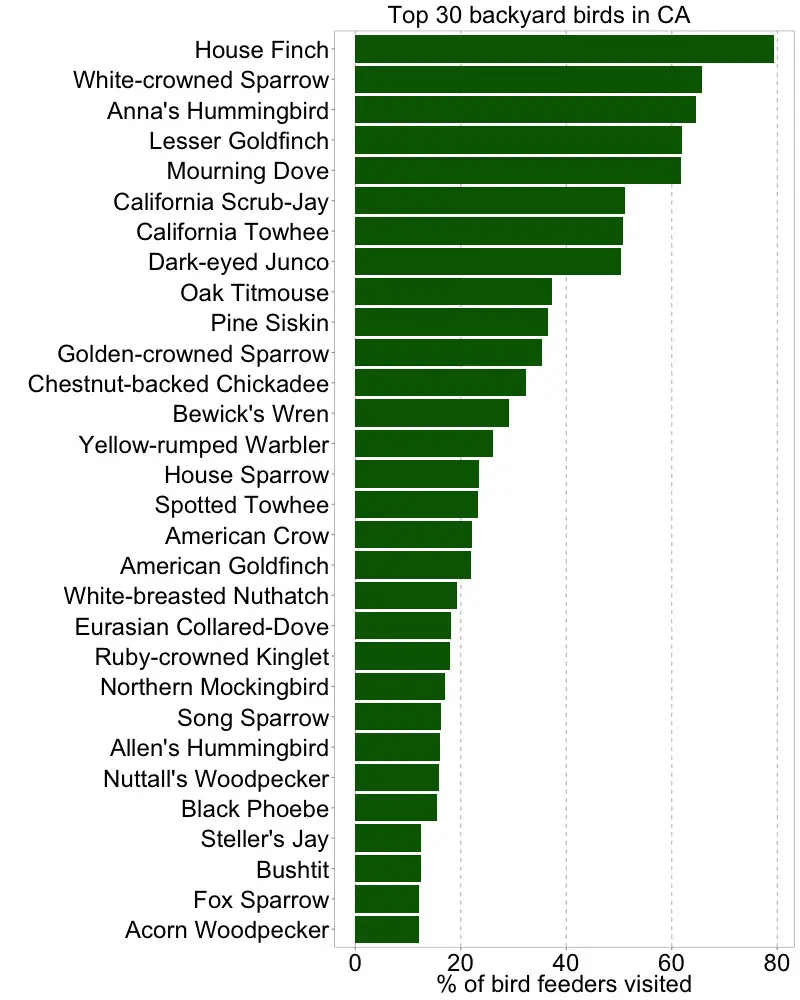
Over the years, these numbers change, and it is interesting to see how certain birds have increased dramatically over the years in California:

The Lesser Goldfinch and the California Scrub Jay were almost not present before their introduction in the late 1990’s.
On the contrary, the House Finch has been the most abundant bird, not just among the smaller birds, but out of all birds in California!
Below you can read more about some of the smallest birds you might observe in California!
Contents
House Finch (Haemorhous mexicanus)
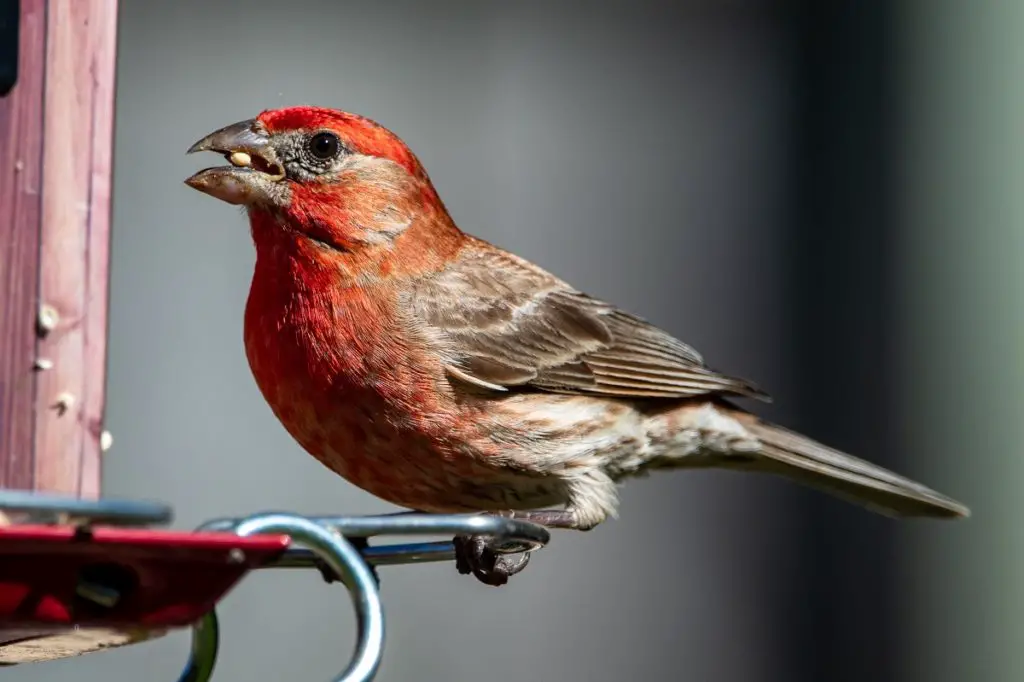
Family: Fringillidae (True finches)
Origin: Southwestern US, and Mexico.
Diet in the wild: Weeds, grains, seeds, fruits, insects.
Feeder type preferences:
- Large Hopper
- Small Hopper
- Small tube feeder
- Large tube feeder
- Ground feeder
Feeder food preferences:
- Black Oil Sunflower Seeds
- Hulled Sunflower Seeds
- Safflower
- Nyjer seeds
Endangered: No.
The House Finch is a medium sized finch of the Finch (Fringillidae) family. It is native to the west coast of the USA and parts of Mexico but was brought to the East coast by petshop owners selling them as pets in New York (Long Island) in the 1940s. Although it was not legal to import and sell non-native birds, their quickly gained popularity as pets lead to the spread of the House Finch throughout the remaining states of North and East America.
From the 1960s the House Finch populations expanded from the Northeast towards the west coast to merge with its indigenous population by year 2000. However, mainly due to the House Finch’s unusual susceptibility to parasitic diseases, its numbers declined slightly in the 1990s but have since rebounded to record highs.
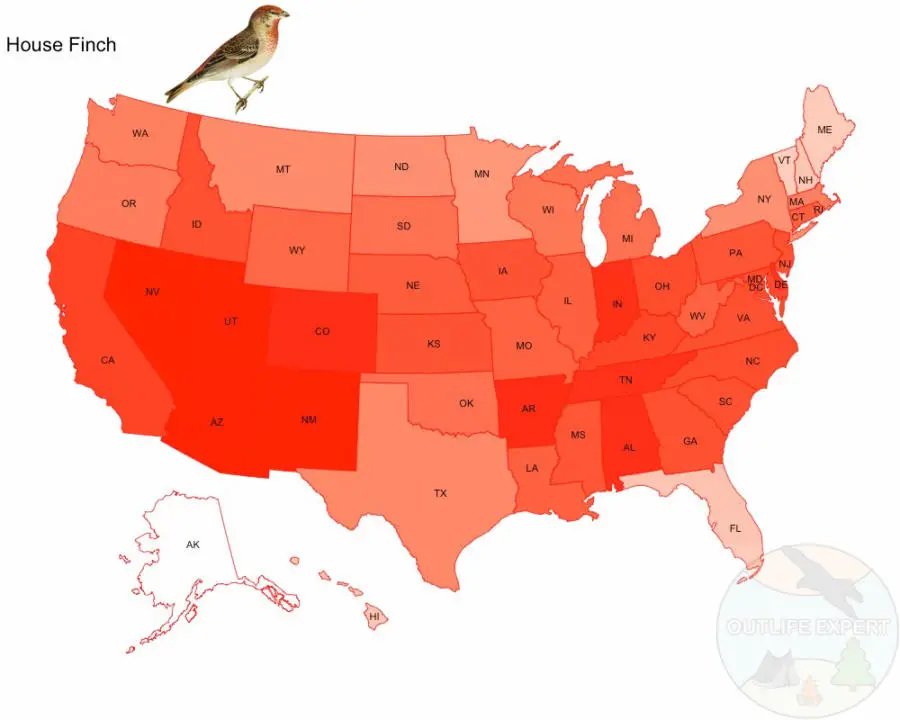
The stronger the red color, the higher the chance that you will see the House Finch in your backyard.
Identification and confusions
The House Finch is a common feeder bird but may be confused with the Purple Finch or the Cassin’s Finch as especially the females are very similar looking. However, there are some subtle but important differences that can help you to distinguish these finches from each other.
Weighing from 16g to 25g the House Finches tend to be slimmer than Purple Finches (20-30g) as well as the Cassin’s Finches (25-35g) and the latter two species have less pronounced markings and longer tails. The colouring of the sister species is more diffuse and covers the head and goes down the back all the way to the tails, whereas the House Finch mostly have markings on the neck and a spot just above its tail.
The House Finch also have a red colour similar to that of the Purple Finch and the Cassin’s Finch, but the latter two have a darker purple or burgundy colour rather than the brighter strawberry red of the House Finch.
Another important fact that will make it easier for you to pinpoint the House Finch is that the Cassin’s Finch is only present in the south-western parts of the US and less associated with gardens and urban areas. The Cassin’s Finch is generally rare at bird feeders and only occurs in the west, so if you live in the east or central parts of the US it is much more likely that the red plumaged Finch at your feeder is a House Finch.
Nesting and mating of the House Finch
During the nesting season from March till August, the female quickly builds a small nest from weeds, grasses, and thin branches. It builds the nest in a matter of days and may place it in trees, hanging vegetation or man-made cavities. Contrary to many other common garden birds, the House Finch does not like to build its nest in man-made bird houses.
The courtship of the House Finch is interesting in that it is sometimes selected based on the type of food it presents to its chosen female on their first date. This ritual may have come about due to the role of the male in feeding the female during the entire egg incubation.
What do House Finches eat and how to attract them?
House finches eat grains, seeds, berries, flower buds and are avid consumers of weeds and smaller insects such as aphids. House Finches are one of the few bird species that prefers to feed their nestlings seeds and other plant material instead of the more protein rich insects. The nestlings prefer dandelion seeds so make sure to keep a few dandelions left in your garden if you want to attract the House Finch.
In Hawaii, the House Finch was introduced in the late 19th century where it quickly became known as the “Papaya bird”. Due to its large intake of papaya instead of the usual seeds and flower buds it would eat elsewhere, the Hawaiian House Finch often had a more yellowish tone compared to the mainland birds.
House Finches are common and very active at bird feeders, and you may use the following seeds to attract the House Finch to your bird feeder:
- Black oil sunflower seeds
- mustard seeds
- millet
- milo
- Cherries
- Apples
- Apricots
You may consider a tube feeder, a hopper feeder, or a Nyjer Feeder to attract the House Finch, however, it is also seen at nectar feeders, where it competes with humming birds for the sweat sap.
It does like to crack open the sunflower seeds and throw the shell on the ground, so make sure to allow for the empty shells to be tossed of easily. So make sure to consider the location of your feeder as shells will collect underneath.
If you really want to make House Finches happy in your garden, you also need a way for them to drink and shower. Especially if the weather is warm, a House Finch may need to drink up to its own body weight in water each day! A bird bath or a shallow pond could work for that purpose.
If, on the contrary, you do not want the House Finch at your feeder, you should make sure to have only nuts, suet, or animal-based feeder material such as mealworms. You should keep dandelions out of your garden and not have any open water around for them to drink or shower.
Looking at prevalence of House Finches at Bird feeders in the United States from 19888 to 2010, we see that the House Finch experienced a drop in the population. This was the case especially eastern and central parts of the US in the early 1990s and was likely due to a high degree of parasite infestations.
The population has later stabilized but the reestablishment has been slow in the United States but is finally on the right track – perhaps because the House Finch collects more in smaller groups (seen from the decreasing flock size in the lower panel). The smaller groups size may have lead to less parasite spread among the birds, but this is not verified.
White-crowned Sparrow (Zonotrichia leucophrys)

Family: Emberizidae
Origin: Western US.
Diet in the wild: Insects, weeds, seeds.
Feeder type preferences:
Ground Feeder
Large Tube feeder
Large Hopper
Platform feeder
Feeder food preferences:
Black Oil Sunflower Seeds
Hulled Sunflower Seeds
Safflower
Crushed peanuts
Millet
Cracked Corn
Endangered: No.
The White-crowned Sparrow can be spotted year-round in the Southern and Western parts of North America. In some areas, the White-crowned Sparrow is so common that it often is jokingly referred to as ‘the bird that ate the West’.
How and where to spot the White-crowned Sparrow
Due to the widespread nature of this bird, it can be found all throughout Southern and Western North America. However, it also occurs in Hawaii and the Caribbean islands. Despite its name it is quite common in eastern North America as well.
The Western population is mostly resident, but the subspecies that occurs in Hawaii, which is smaller and has darker plumage, is migratory.
The Northern White-crowned Sparrow may irrupt, that is, increase its range, following an abundant food source, usually after wildfires.
The White-crowned Sparrow is abundant year-round, but especially after a rainfall.
The male has a distinctive white crown which can only be seen in breeding plumage. During the breeding season, the male tends to sing a much louder and more melodic song.
The female is brownish gray with a light stripe along its back. However, when seen side-by-side, the male is easily recognizable.
Habitat and mating of the White-crowned Sparrow
The White-crowned Sparrow prefers open habitats, such as grasslands, deserts, and agricultural lands. It also occurs in backyards.
The nest is built in a bush, usually less than 3 m (10 ft) above the ground. The female lays 2-4 white eggs.
The male has a varied diet, from seeds to insects to fruits and berries. During nesting season, however, it feeds almost exclusively on insects.
The Breeding Bird Survey shows a 95% population increase between 1966 and 2014 in California.
Anna’s Hummingbird (Calypte anna)

Family: Trochilidae
Origin: Coastal California.
Diet in the wild: Nectar, insects, spiders, and flower sap.
Feeder type preferences:
A variety, including inverted cups, tubular feeders, and platform feeders.
Feeder food preferences:
Nectar
Sugar water
Endangered: No.
Anna’s Hummingbird, named after the amateur ornithologist Anna Allen, is a small bird about five inches long. It is native to coastal California, USDA Plant hardiness zones 8B and 9B. However, in 1983, it was introduced to Washington state, and in 1990, it was introduced to British Columbia.
How and where to spot the Anna’s Hummingbird
Anna’s Hummingbird is elusive and hard to see as it darts from flower to flower, playfully hanging upside-down to feed on nectar. This hummingbird is known for its beauty and grace, making it desirable for many gardens.
Anna’s Hummingbird is the more common hummingbird along the West Coast, and in many regions of the US, it is the most abundant hummingbird.
Its habitat suits it well as Anna’s Hummingbird thrives in the lush, coastal California forests where it can often be seen perching upside-down on tree branches.
Some Anna’s Hummingbirds migrate as far as British Columbia and New Mexico.
Habitat and mating of the Anna’s Hummingbird
Anna’s Hummingbird is a Seasonal breeder, meaning that it breeds and lays eggs only once a year.
The male Anna’s Hummingbird attracts the female with elaborate courtship displays, and the pair bonds by nesting together.
Furthermore, the females lay 2-4 eggs per nest, and both the male and female incubate the eggs. After leaving the nest, the chicks are totally dependent on the adults for food for about 3-4 weeks.
Anna’s Hummingbirds are unique in that they build hanging nests by weaving together flower petals, spider silk, and lichens. It is also the only North American hummingbird with a straight, pointed beak, unlike its other long-beaked, exotic cousins.
Anna’s Hummingbird is a gorgeous, tropical-looking bird, and it is common to see Anna’s Hummingbirds as pets, as they are easy to care for and fun to watch. However, I would strongly advice against keeping them as pets!
Dark-eyed Junco (Junco hyemalis)
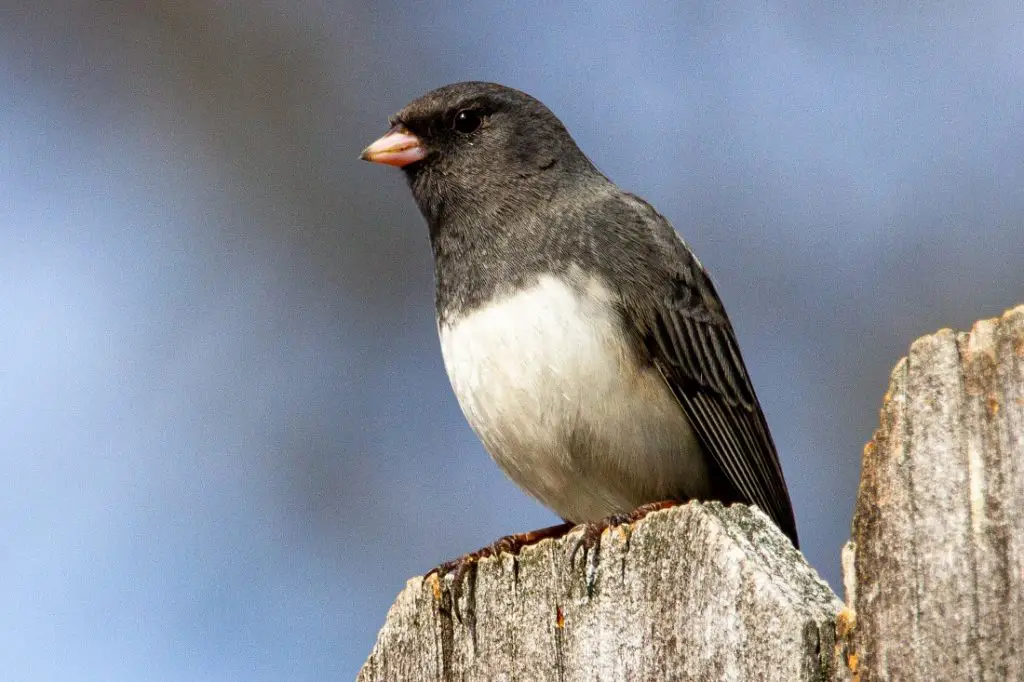
- Large Hopper
- Platform feeder
- Window feeder
- Ground feeder
- Black Oil Sunflower Seeds
- Hulled Sunflower Seeds
- Safflower
- Cracked Corn
- Crushed peanuts
- Millet
- Oats
- Milo
- Nyjer seeds
- Suet
Dark-eyed Juncos are one of the most abundant and widespread forest birds in North America, with populations estimated to be anywhere from 200-630 million. They are part of the New World Sparrows family, Passerellidae. “Dark-eyed Junco” actually refers to a broad group of birds in the sparrow family, with 16 identified sub-groups that live broadly across North America. Many of these sub-groups were at one point considered different species.
Juncos are small birds, weighing 18-30 g (5/8-1 1/16 oz) with a wingspan of only 15-17 cm. They live in flocks and are generally dark gray or brown, with a pink bill and white outer tail.
Their appearance and colouring vary depending on geographic location. Across Canada and northeast US, you can find “slate-coloured” populations, and “white-winged” birds nest in the Black Hills mountains in South Dakota.
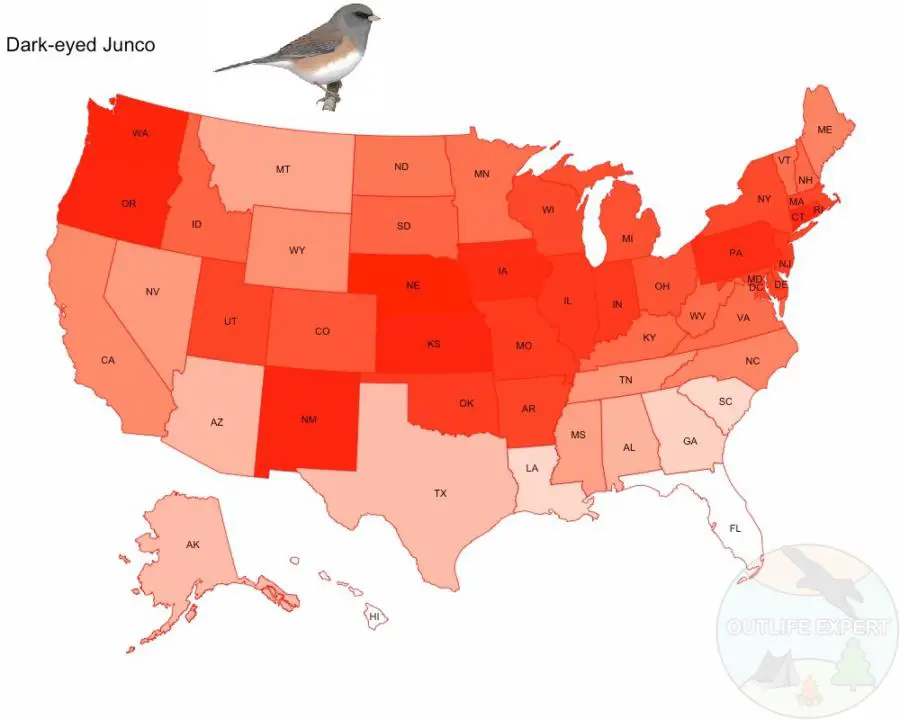
The stronger the red color, the higher the chance that you will see the Dark-eyed Junco in your backyard.
“Pink-sided” juncos can be found in Idaho, Montana, and Wyoming, and “Red-backed” populations live in the mountain regions of Arizona and New Mexico. The “Gray-headed’ Junco live in the geographic areas between the “Pink-sided” and “Red-backed” ranges. Finally, the “Oregon” Junco resides (unsurprisingly) in Oregon! It can be found along the majority of the West coast of North America, from Mexico to Alaska.
Whereas the appearance varies greatly among sub-species, the female Juncos tend to be paler and more brown, almost to the point where they may be confused with tree- or house sparrows.
Where to find the Dark-eyed Junco
They prefer open spaces like backyards, parks, roadsides, fields, and forest. Juncos are ground birds, so look for them hopping between shrubs, low branches, and lawns. The different colour varieties have separate ranges in the summer, but winter migration to new ranges can cause them to flock together.
In the winter, Dark-eyed Juncos migrate south, ranging from southern Canada to northern Mexico, but they tend to avoid Florida. While most Juncos are migratory, some of the populations in the southwest and on the southern Pacific coast may not migrate. Females tend to winter in slightly more southern locations than males.
The Dark-eyes Junco is known casually as ‘snowbirds’ due to arriving at birdfeeders during winter snowstorms.
Feeding the Dark-eyed Junco
Seeds make up about 75% of Dark-eyed Junco’s diet, but will also eat insects and berries, particularly during the breeding season. If you want to attract them to your yard, they are very comfortable going to feeders.
You can use a large hopper, a platform feeder and scatter seeds on the ground. They definitely prefer millet to sunflower seeds. You can see them hopping on the ground as they forage.
Breeding & Nest Building
Despite a wide variety in range, the Dark-eyed Junco consistently breeds in forests, preferring coniferous or mixed woodlands on the edges of clearings or other open spaces.
Dark-eyed Juncos breed from May-August, hatching 1-3 broods with 3-6 eggs per brood. Females will choose the nest location and build the nest in 3-7 days. Nests are generally on the ground, in well-hidden locations and are rarely more than 10 feet off the ground. In more populated areas around humans, they sometimes make their nests in buildings, window ledges, light fixtures and hanging flower pots.
Females weave the materials together to form an open cup, which can include twigs, grasses, leaves, moss, ferns, and hair. Juncos don’t reuse nests, preferring to build new ones each season. The female incubates the egg, which takes 11-13 days.
The male will protect his nesting territory by singing from a high perch. Both parents will feed the nestling, which leaves the nest 9-13 days after hatching.
Occasionally, a Dark-eyed Junco will mate with a White-throated Sparrow, leading to a hybrid bird that looks like a more gray White-throated Sparrow with white outer tail feathers.
House Sparrow (Passer domesticus)

Family: Passeridae (Old world sparrows)
Origin: Middle East, but now worldwide.
Diet: Weeds, grains, seeds, insects.
Feeder type preferences:
- Large tube feeder
- Large hopper feeder
- Small hopper feeder
- Platform feeder
- Window feeder
- Ground feeder
Feeder food preferences:
- Black Oil Sunflower Seeds
- Hulled Sunflower Seeds
- Safflower
- Flax seeds
- Canary seeds
- Crushed peanuts
- Millet
- Milo
Endangered: No.
I have never been in a country, from Northern Sweden to New Zealand, without seeing the House Sparrow happily hopping around. The House Sparrow and its relatives in the Passar genus are perhaps the most common birds in the world. The omnipresence and familiarity of many households with the bird, is reflected in the first part of its common name “house” or the last part of the Latin name “domesticus” – literally meaning “near the house”.
The House Sparrow is highly adapted to the presence of humans and thrives in urban areas where they are very common guest of backyard bird feeders.
The House Sparrow is believed to originate from the Middle East from where it spread to Asia, North Africa and Europe following the human appreciation of agriculture. Due to widespread introductions, facilitated by human sea travel, the House Sparrow is now found pretty much everywhere where humans reside!
The vast populations and geographical spread of the House Sparrow mean that several subspecies have evolved and slight differences in their appearance are seen throughout different regions of the world.
Being introduced to the US for the first time in the 1850s via a ship headed for Brooklyn in New York, they are now very common throughout urbanized parts of the country. Although common near humans, the House Sparrow is far less present in the vast forests of the most northern parts where the temperatures are more extreme and bird feeders rare.
The House Sparrow is currently most common in the central and northeastern parts of the US. The population has seen a very slow decline over time but seems to have stabilized in recent years.
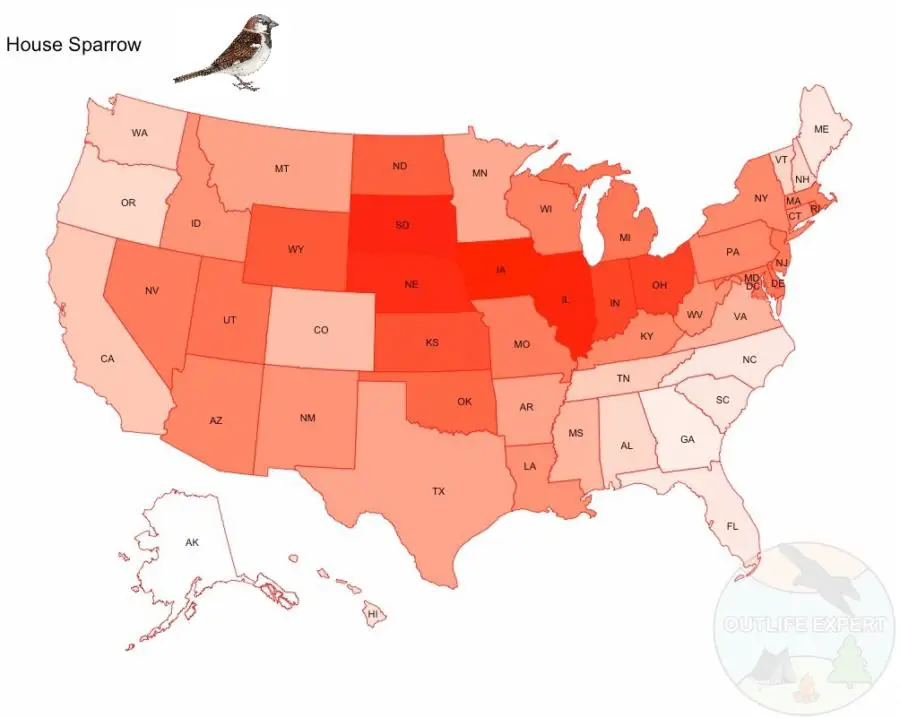
The stronger the red color, the higher the chance that you will see the House Sparrow in your backyard.
Are House Sparrows invasive?
Because the House Sparrow has been introduced to most of its current habitats, it is, per definition, invasive. House Sparrows are so widespread across the planet and survives so well in many environments, that it continues to expand its habitat. Such rapid habitat expansion always comes at the expense of native species. Therefore the House Sparrow readily outcompetes native bird species, and does so partly by stealing nests from other birds – even when in already in use!
Although the House Sparrow was originally introduced to the United States to control pests in agriculture, the House Sparrow was later sought eradicated because considered a pest itself – eating crops from wheat and fruit farms. However, it later turned out that it is more of a benefit than a plague to most American agriculture, and therefore is not considered a plague.
How and where to spot the House Sparrow
Being a sparrow, it is small in size with a length of 15 to 17cm (5.91-6.7 inches) and a weight of around 30g (1.06 oz). The males are usually larger than the females and differ in display a darker plumage. The back feathers of the male House Sparrow are generally dark brown, and the males have dark gray to black patches on the throat and on the top of their head. The females and juvenile House Sparrows are light brown, with less pronounced patches on their head and no dark area under their bill.
Due to the varied plumage of the House Sparrow, and the many similar sparrows within the Passeridae family, it may be confused with other true sparrow species such as the Harri’s Sparrow, the White-throated Sparrow, and especially the Eurasian Tree Sparrow. The latter was introduced to North America along with the House Sparrow in the 19th century but is only vaguely present and is now restricted to Iowa, Missouri and California.
The huge success of the House Sparrow can be attributed to their early association with human farmers, that have given them time to evolve and adapt to human settlements and urbanization. This fact is reflected in their high presence in cities compared to less populated areas such as forest, mountain ranges and deserts.
Whereas the largest numbers are found in densely populated cities, the House Sparrow tends to breed more efficiently in the province where more insects and nesting opportunities are available.
Nesting of the House Sparrow
Any appropriately-sized cavity will serve as a nesting site for the House Sparrow couple. The couple is usually monogamous and partner for life. The House Sparrow may build its own nest, but more often takes a nest previously used by other birds. Because the House Sparrow may scare away or kill the original inhabitants of nests it would like to overtake, it is considered a threat to other less abundant smaller birds.
Single sparrows help couples!
If a young House Sparrow does not find a mate, it may seek out established couples and help them with foraging and keeping the nest safe from predators. It is believed that this behavior allows the single members of the sparrow population to gain attractiveness by gaining experience and demonstrating their abilities.
What does the House Sparrow eat and how do I attract it?
The House Sparrow feed mostly on seeds, grains, and smaller insects but are, like pigeons, somewhat omnivorous – living on whatever food leftovers they find laying around. During its breeding season, it prefers mostly protein-rich meals such as caterpillars, beetles, and flies.
Although rarer, it is also seen feeding on larger animals such as snails, spiders, and lizards.
Because the House Sparrow has basically adapted to your backyard, it is not hard to attract it! It will come for just about any eatable seed that fits its bill but will also pick on larger fruits and especially berries. It is not very shy and will jump onto tables and may even enter houses to look for leftover foodstuff.
The House Sparrow prefers seeds and therefore tube feeders are ideal for attracting it. It eats most commercial bird seed mixes, but you may look for these particularly favored seeds for your feeder:
- Black Oil Sunflower Seeds
- Hulled Sunflower Seeds
- Safflower
- Flax seeds
- Canary seeds
- Crushed peanuts
- Millet
- Milo
How to prevent the House Sparrow from coming to my feeder?
Because the House Sparrow is easily attracted to bird feeders, many people deal with another problem: How to get rid of it!
The House Sparrow can be loud and tends to throw around seeds and scare away other more shy feeder birds. If you find the House Sparrow annoying to have at your bird feeder, you should avoid the seeds listed above and try adding more thistle seeds, whole peanuts, nectar, or suet to your bird feeder.
Alternatively, you can create a so-called “sparrow spooker” consisting of shiny tin foil bands hanging from a stick near the feeder, which supposedly will scare off sparrow while not bothering most other backyard birds.
How old did the oldest House Sparrow get?
The oldest know House Sparrow was reported in Denmark and reached almost 20 years of age! This is much longer than the average age of 3 years normally observed for this, and most sparrow species.
American Goldfinch (Spinus tristis)
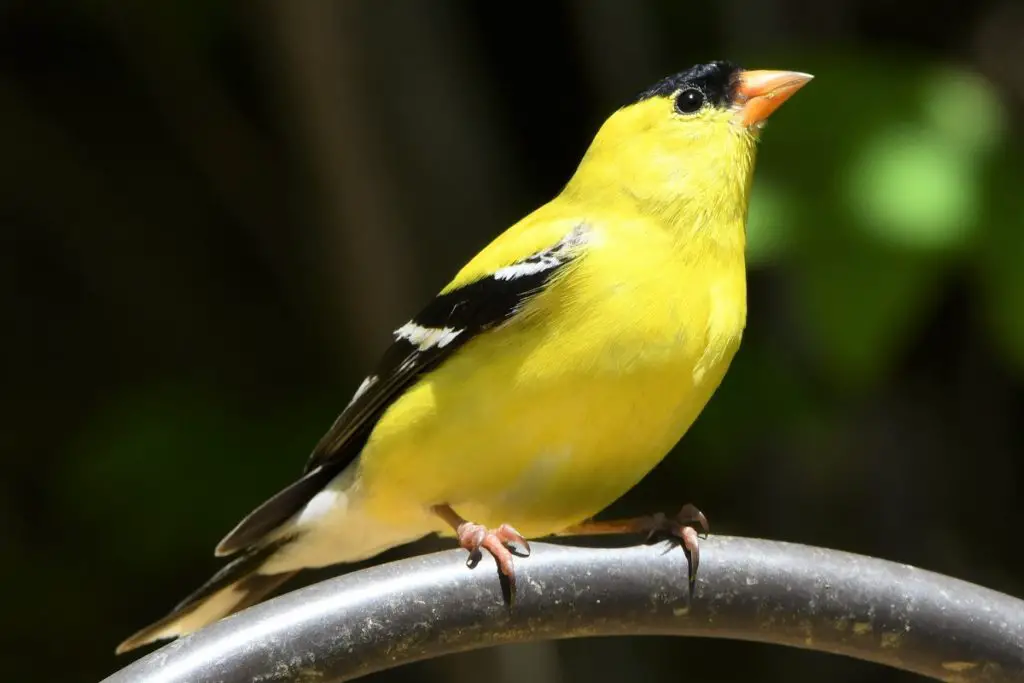
American Goldfinch summary:
Family: Fringillidae
Occurrence: Southern Canada to California in the summer. Also Florida and Mexico in winter.
Diet in the wild: Seeds, insects.
Feeder type preferences:
- Large tube feeder
- Small tube feeder
- Ground feeder
- Large hopper feeder
- Small hopper feeder
- Platform feeder
Feeder food preferences:
- Black Oil Sunflower Seeds
- Hulled Sunflower Seeds
- Nyjer (Thistle) seeds
Endangered: No.
The American goldfinch is a small garden bird commonly found in large flocks throughout the US, southern Canada, and central Mexico. As short-distance migratory birds, they move south during the winter to escape the cold.
During summer they are found from southern Canada to California and North Carolina. During winter, they can be found from Washington to Nova Scotia south into central Mexico. Their natural habitat is open meadows, but they often flock towards bird feeders in suburban areas. They are the official state bird of three US states: Iowa, New Jersey, and Washington.
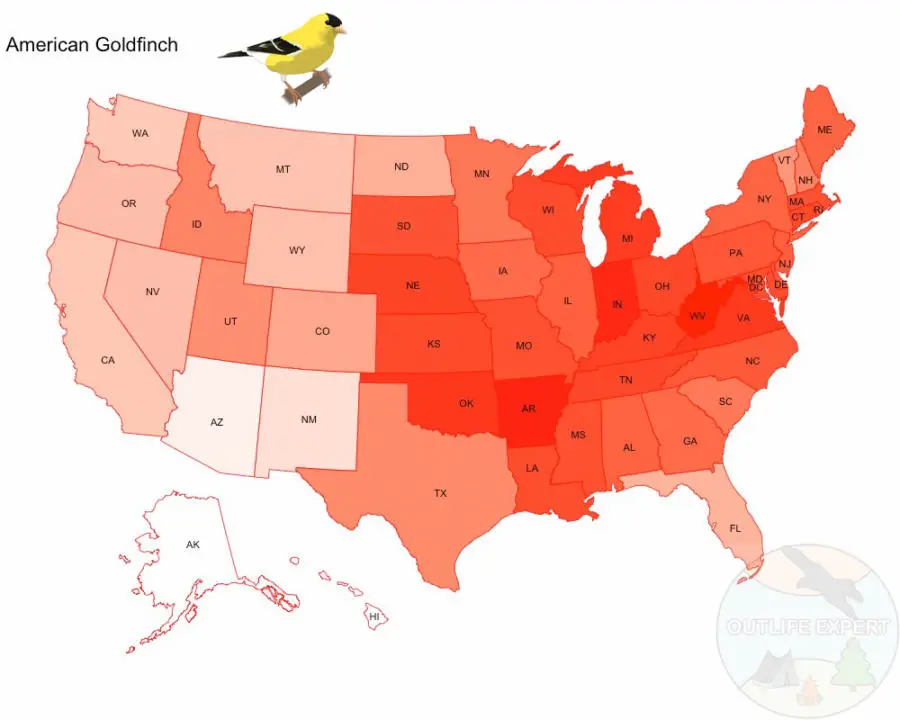
The stronger the red color, the higher the chance that you will see the American goldfinch in your backyard.
The American goldfinch belongs to the Fringillidae (finch) family. There are four subspecies: the eastern goldfinch, the pale goldfinch, the northwestern goldfinch, and the willow goldfinch. Other closely related species include the lesser goldfinch, Lawrence’s goldfinch, and the siskins. Despite the similar sounding name, they are not related to the European goldfinch.
Identifying the American goldfinch
The American goldfinch is a 4 to 6-inch, brown to yellow bird with a white undertail. Their wings and tail are black with white markings. In summer, the male is easily distinguishable with his bright yellow plumage and black cap. The female has a pale-yellow underside in the summer months with an olive-colored head and back. In winter, both males and females are olive-brown with a yellowish head. Juveniles are a dull brown with pale yellow undersides. Their call is a chirpy “tsee-tsi-tsi-tsit”.
Subspecies can be distinguished by their distribution and small variations in coloration and size. The eastern goldfinch is the most common and most eastern subspecies. They occur from Colorado eastwards from southern Canada to central Mexico.
The slightly larger pale goldfinch, as its name suggests, has a paler body, stronger white markings, and a larger black cap in the male. They have a more western range stretching from British Columbia to western Ontario south to Mexico.
The northwestern goldfinch is darker and smaller compared to the other subspecies. They occur along the coastal slope of the Cascade Mountains from southern British Columbia to central California. The willow goldfinch has a browner winter plumage, and in summer, males have a smaller black cap. They are found to the west of the Sierra Nevada range in California southwards into Baja California.
The male lesser goldfinch could be confused with the male American goldfinch but their cheeks and back are olive to black instead of yellow and the black crown of the male covers its entire head. In both males and females, the lesser goldfinch has a yellow undertail, instead of white. The Lawrence’s goldfinch male has a black face and yellow breast, but the rest of its body is grey. Females of Lawrence’s goldfinch have a grey head and back, whereas the American goldfinch has a yellow head and olive back.
Yellow birds in California
Did you spot a yellow bird in your backyard? There are several different yellow bird species, but not all of them are equally common!
Seeing a bright yellow bird in your backyard can be an eye-catching sight. Luckily, yellow birds are not rare in North America, but there are clearly some species that are more common than others. If you see a yellow bird though, it is most likely a Goldfinch or a Warbler!
In California, the American Goldfinch is the only really bright yellow bird and is the yellow bird you are most likely to see in your backyard. Other yellow birds that you may have a chance of luring to your bird feeder in California at a fairly high rate are the Yellow-rumped Warbler, the Orange-crowned Warbler, the Pine Warbler, and the somewhat yellow Pine Siskin and Yellow-bellied Sapsucker.
Breeding and feeding of Goldfinches
The American goldfinch’s diet consists entirely of seeds. Their breeding season starts in June, when seeds are in greatest supply. Monogamous pairs nest in trees or shrubs. Their nest is an open cup of three inches, woven from plant fibers, bound by spiderwebs and caterpillar silk, and lined with plant down. They will lay four to six eggs, each less than an inch long, pale bluish white, with occasional brown spots.
Attracting the American goldfinch to your backyard
To attract the American goldfinch, you can put out various seeds (especially sunflower and nyjer seeds), and beet greens. Use a feeder designed for smaller birds, because large birds at the feeder could discourage the American goldfinch. During the breeding season, you can put out 100% cotton for them as nesting material. Plant indigenous grasses, sunflowers, thistles, dandelions, coneflowers, milkweed, zinnias, and large trees in your garden. A bird bath or water feature would provide an additional attraction.
Is the american goldfinch endangered?
The American goldfinch is listed as least concern since its population is generally increasing across the United States. However, climate change could cause southern contractions in their distribution with local extinctions in various states, due to the increased risks of heatwaves and heavy rainfall endangering their eggs and chicks.
White-breasted Nuthatch (Sitta carolinensis)
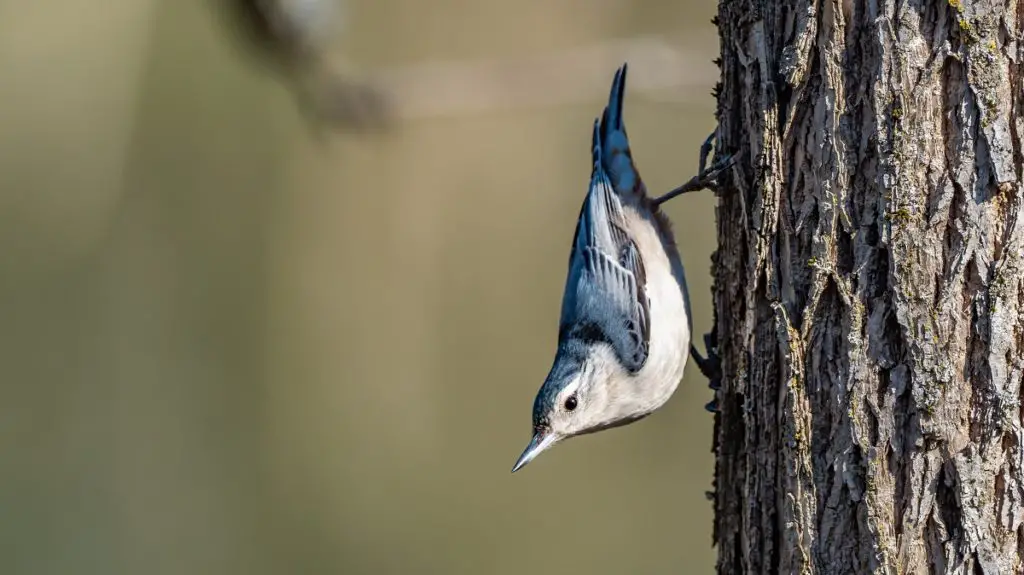
Family: Sittidae
Occurrence: Throughout United States, Canada, and Mexico when forest is present.
Diet in the wild: Insects in the summer, seeds in the winter.
Feeder type preferences:
- Large tube feeder
- Small tube feeder
- Suet Cage
- Large hopper feeder
- Small hopper feeder
- Platform feeder
Feeder food preferences:
- Suet
- Black Oil Sunflower Seeds
- Hulled Sunflower Seeds
- Safflower
- Mealworms
- Crushed peanuts
- Whole peanuts
Endangered: No.
The white-breasted nuthatch is a common garden bird in western Canada, large parts of Mexico, and most of the US (except for Alaska, Nevada and Louisiana).
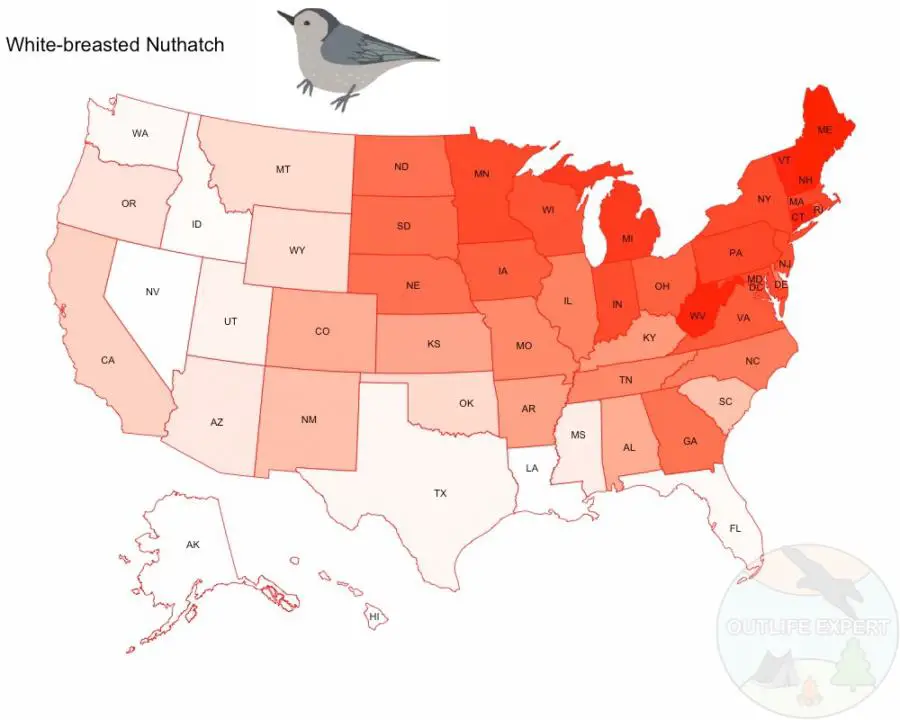
The stronger the red color, the higher the chance that you will see the white-breasted nuthatch in your backyard.
They get their common name from their white breast and their habit to wedge a food item in a crevice and hack them open with their strong bills. They are mostly found in monogamous pairs, but during winter they will sometimes flock with other bird species. They belong to the nuthatch family, Sittidae, and are closely related to wallcreepers, treecreepers, wrens, and gnatcatchers.
There are three other nuthatches in North America: the red-breasted nuthatch, the brown-headed nuthatch, and the pygmy nuthatch.
Identifying the white-breasted nuthatch
White-breasted nuthatches are 5 to 6 inches, have a large head, short tail, and wings, strong bill,s and feet. They have blue-grey upperparts with white underparts and face and a black cap extending down to a black bar across the nape of its neck.
They have black and white markings on their wings and tail and a rust-colored undertail.
Females have a slightly narrower nape band, and their coloring is slightly less contrasted than that of the male and their cap is sometimes grey. However, it is often difficult to distinguish males from females in the field.
Juveniles have duller plumage than adults. They have a wide repertoire of vocalizations, but their most distinctive vocalization is a “Kri-Kri-Kri-Kri” call. There are nine subspecies of white-breasted nuthatch, all visually similar with only slight variations in color, size and bill shape.
None of the other nuthatches in North America have a completely white face. The red-breasted nuthatch has a black eye line, white brow, and a reddish breast. Both the brown-headed nuthatch and the pygmy nuthatch are smaller and have a brown cap instead of black. In the black-capped chickadee, the black cap covers its eyes, and it has a black bib.
Where and when does the white-breasted nuthatch nest?
The white-breasted nuthatch breeds in woodland habitats across North America. Their breeding season is between May and June. The male performs a courtship ritual where he spreads his tail, droops is wings and bows to the female while he sways back and forth.
They use natural cavities or old woodpecker nests in trees for nesting. They form a cup of bark, grasses, twigs, and hair. They will lay five to nine eggs, each less than an inch long, cream colored with brown speckles.
In summer, they eat mostly insects, but in winter, when insects are in short supply, they supplement their diet with seeds and nuts. Their chicks feed almost exclusively on insects.
During autumn and winter, they will stash food from bird feeders in bark crevices for later use.
How to attract the white-breasted nuthatch to your garden
The white-breasted nuthatch will visit bird feeders for sunflower seeds, peanuts, suet, and mealworms.
In your garden, you can plant large trees such as oak, birch, and hickory to provide food and potential nesting sites.
Create an insect-friendly garden with lots of indigenous plants and shrubs, a thick mulch layer, and dead logs.
Do not use insecticides in your garden. Insecticides not only kill the insects that birds feed on, but could also result in secondary poisoning when birds eat poisoned insects.
Is the white-breasted nuthatch endangered?
The white-breasted nuthatch is listed as least concern, since its population is increasing. However, forest clearance and the removal of dead trees can lead to reduced numbers locally, but may lead to more white-breasted nuthatches to seek towards backyards and birdfeeders in cities.
Their natural predators include birds of prey and snakes. Squirrels compete with nuthatches for tree cavities and will eat their chicks and eggs. Despite these threats, the white-breasted nuthatch is doing quite well in California.
The increased threat of wildfires and spring heat waves due to climate change is causing a northward range shift, which could cause them to go locally extinct in the southern states of their distribution.
From the graph below, you will see that the white-breasted nuthatch is actually getting increasingly more common at bird feeders in California. However, this does not necessarily mean that its general population is increasing. It could also mean that the nuthatches seek from the forest towards the cities to obtain food. Either because their habitats are disappearing or simply because backyards are getting more attractive, e.g having more trees or bird feeders, for the nuthatches to enjoy.
Backyard birds in other states
Are you interested in how the backyard birds in your state compare to other states?
Then check out my other blog posts below:
- Backyard birds of Alabama
- Backyard birds of Colorado
- Backyard birds of Delaware
- Backyard birds of Georgia
- Backyard birds of Hawaii
- Backyard birds of Illinois
- Backyard birds of Iowa
- Backyard birds of Kentucky
- Backyard birds of Louisiana
- Backyard birds of Maryland
- Backyard birds of Massachusetts
- Backyard birds of Missouri
- Backyard birds of Nebraska
- Backyard birds of New York
- Backyard birds of North Carolina
- Backyard birds of Oklahoma
- Backyard birds of Rhode Island
- Backyard birds of South Carolina
- Backyard birds of Tennessee
- Backyard birds of Texas
- Backyard birds of Virginia
- Backyard birds of West Virginia
- Backyard birds of Wisconsin
- Backyard birds of Wyoming
And in Canada:
- Backyard birds of Ontario
- Backyard birds of Prince Edward Island
- Backyard birds of Saskatchewan
- Backyard birds of Quebec
Not on the list? Check out the rest of my posts on backyard birds here!
Maybe you would like to know if the Blue Jay or Cardinal dominates in the bird feeder hierarchy or how birds such as seagulls sleep at night? Or why mourning doves poop so much and whether most birds can poop and fly at the same time!
A lightweight handy pair of binoculars is a must for your backyard bird watching! Check out my recent post on the best small lightweight binoculars for birdwatching etc.
My Favorite Backyard Birding Gear:
- Photographs and identifies birds coming to your bird feeder!
- Notifies you via the app whenever a bird stops by!
- Excellent resolution and battery performance with the 6MP image sensor.
- Connect from anywhere with internet access (watch birds even when you are not at home!)
- Count the birds visiting your feeder and contribute to projects such as FeederWatch!
If you are interested in posters and other wall arts etc. with drawings of all the backyard birds you have just read about, check out my portfolio over at Redbubble:
Acknowledgements
I want to thank the Cornell Lab of Ornithology at Cornell University and the Birds Canada organization as well as all the citizens who have been involved in the FeederWatch project for providing the data of this article. The data I have used to generate the prevalence numbers for this article is provided by the FeederWatch project. The FeederWatch project is an initiative by The Cornell Lab of Ornithology at Cornell University and the Birds Canada organization. The data is collected through an immense crowdsourced citizen science program, where citizens of the United States and Canada are invited to count birds at their bird feeders, identify the species, and report back to the scientists at Cornell University. The birds are counted from November to April and always in two consecutive days including only one area with a bird feeder, typically a piece of the backyard, observed from one vantage point. The two-day watch is then repeated throughout the season. The data is collected each year and is freely available to the public at https://feederwatch.org/.
References
American Museum of Natural History Birds of North America. DK; Revised edition (September 6, 2016). ISBN: 978-1465443991
National Geographic Backyard Guide to the Birds of North America, 2nd Edition. National Geographic; 2nd edition (October 15, 2019)
Birds of North America. National Audubon Society. (Knopf April 6, 2021). ISBN: 978-0525655671

